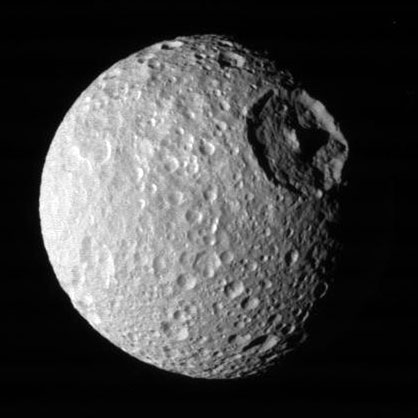Mimas
| Discovery | |
|---|---|
| Discovered by | William Herschel |
| Discovered in | 1789 |
| Orbital characteristics | |
| Semimajor axis | 185,520 km |
| Eccentricity | 0.0202 |
| Orbital period | 22 h 37 min 5 s |
| Inclination | 1.53 ° |
| Is a satellite of | Saturn |
| Physical characteristics | |
| Mean radius | 198.6 km |
| Mass | 3.84×1019 kg |
| Mean density | 1.17 g/cm3 |
| Surface gravity | 0.077 m/s2 |
| Rotation period | 22 h 37 min 5 s (synchronous) |
| Axial tilt | 0.005 ° |
| Albedo | 0.77 |
| Atmosphere | none |
Mimas is a moon of Saturn that was discovered in 1789 by William Herschel. Mimas' low density (1.17) indicates that it is composed mostly of water ice with only a small amount of rock.
Mimas' most distinctive feature is a colossal impact crater 130 km across, named Herschel after the moon's discoverer. Herschel covers almost 1/3 of the diameter of the entire moon; its walls are approximately 5 km high, parts of its floor measure 10 km deep, and its central peak rises 6 km above the crater floor. If there were a crater of an equivalent scale on Earth it would be over 4000 km in diameter, wider than Canada. The impact that made this crater must have nearly disrupted Mimas entirely; fractures can be seen on the opposite side of Mimas that may be due to the shock waves from the impact travelling through the moon's body.
The surface is saturated with other smaller impact craters, but no others are anywhere near the size of Herschel. Comparisons have been made between Mimas' appearance and the appearance of the Death Star from the movie Star Wars. Although Mimas is heavily cratered, the cratering is not uniform. Most of the surface is covered with craters greater than 40 km in diameter but in the south polar region, craters greater than 20 km are generally lacking. This suggests that some process removed the larger craters from these areas.

